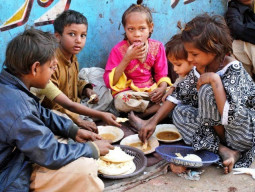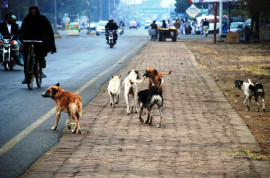
Ali, 40, died that night of June 12. Beenish, 14, Nadia, 12, and Aymen, 10, died in the days that followed. Ali’s wife Muzzammil survived, along with Kaynat and her young siblings Raza and Aisha. The latter two were asleep when their father was handing out poison to the rest of the family.
The family tragedy caused a media storm. Apoplectic anchors railed against the rising prices that were forcing people like Ali to kill themselves and their families in financial despair. One television journalist even broadcast a special programme straight from the family home as one of the surviving children slept in her arms.
Apart from sympathy, the media coverage won the family a Rs1 million cheque from the Punjab government, as well as donations from various other quarters. But over six months later, despite all the charity money, Muzzammil and her children face the same financial hardships that drove Ali to suicide.
Muzzammil says that the family’s financial problems piled up gradually. Ali contracted hepatitis B four years ago, which would often force him to take days off from driving the rickshaw. Muzzammil lost some gold worth over a million rupees. Half of it belonged to Ali’s brother Amjad, so he had to put his Shahpur Kanjaran house under Amjad’s name. That led him to borrow Rs200,000 from a moneylender named Sarwar. He also took Rs200,000 from Seema. And three days before his death, Muzzammil says Ali borrowed Rs22,000 from Azra, who runs Daman, a money lending group. Azra insists that Ali actually took Rs200,000.
The debts haunt Muzzammil constantly. “Sometimes, the pressure to pay them off makes me consider suicide,” she says.
After her husband and three daughters’ deaths, ‘compensation’ came from various sources. The chief minister gave a Rs1 million cheque, only for Amjad to promptly sue her for that money. He claimed she was the cause of Ali’s death and their kids should be given in his custody.
A media group hired Muzzammil a lawyer who helped her win the case. She then bought a house in Thokar Niaz Baig, spending virtually all the money. She lives there today with her children and father-in-law.
She makes about Rs6,000-7,000 a week stitching clothes for women and children. She makes Rs100 from each adult outfit and Rs60 from each child outfit. Sometimes she goes to her brother’s neighbourhood in Ali Town, a comparatively well-off area, to get customers, since they are willing to pay more. She gets Rs3,000 a month of her father’s pension and Rs5,000 a month from a philanthropist based in England. She also makes up to Rs100 a day by making slippers.
But the money she makes goes mostly into debt servicing. Until two months ago, she paid approximately Rs15,000 per month to the three women Akbar took money from. Sarwar is still owed Rs125,000. Azra has demanded Muzzammil pay her Rs200,000 with interest. She pays Rs6,000 a month to Seema.
She has not paid back any of the debt in the past two months. Over the winters, she stopped receiving donations from the sympathiser in England. She also fell sick from the cold, which kept her from stitching clothes. The after-effects of the poison still affect her. She complains of vomiting, swelling of the legs, water retention and stomach disorders.
Unable to pay her debtors, she has taken on a few new ones.
She now owes more in interest payments per month than she makes and the debts are increasing. Still, she says she is not giving up. “I am determined to pay off the loans. Indebtedness has taken my husband and my girls away. I cannot afford to let go of the three I’m left with,” she says.
The children study at the nearby Rehman Public School. Initially they studied free, but she says the school has now started charging the two older children.
Muzzammil says that Kaynat used to be a cheerful, happy child. Since her father attempted to kill her, she has been quiet and morose.
Poverty is cited as the most common cause behind suicide in Pakistan. According to data obtained from the Human Rights Commission of Pakistan (HRCP), 13 people committed suicide in 2010 after killing other family members, either by poisoning or gun shot, as a result of hopelessness brought on from financial despair.
Two weeks after Ali’s poisoning of his girls and wife, on June 26, a family of six attempted suicide in Karachi’s Liaqatabad area. They were reported to be heavily in debt.
A Punjab government official explained how the question of compensation is decided. “After the chief minister takes notice, either through the media or appeals for help at the secretariat, we order the local administration to inspect the socio-economic circumstances of the claimant.
Then the chief minister approves and issues a cheque through the Finance Department. There is no check on how that money is spent,” says Faisal Rasheed, a deputy secretary (Finance).
Dr Mehdi Hasan, the HRCP chairman, suggested that the Punjab government should also invest time and energy in ensuring that the compensation money is not wasted. “The Social Security Department could get the responsibility to make sure the money is safely invested,” he said.
He added that the department should also initiate small-scale projects to give financial help to such families in the long term. “Handing money over is not the solution. Using it to the maximum benefit of an aggrieved family is,” he said.
Published in The Express Tribune, February 11th, 2011.


















COMMENTS
Comments are moderated and generally will be posted if they are on-topic and not abusive.
For more information, please see our Comments FAQ